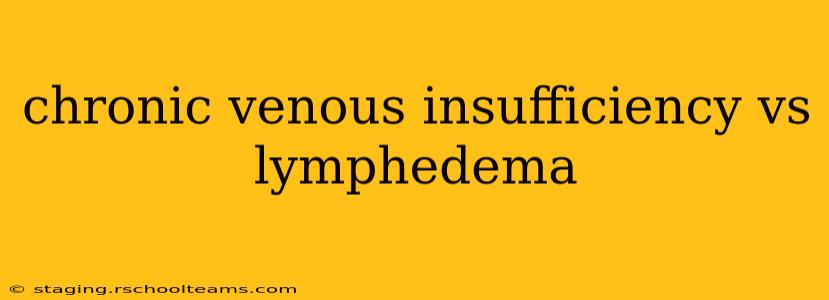Chronic venous insufficiency (CVI) and lymphedema are both conditions that cause swelling in the limbs, often the legs. This similarity can make it challenging to distinguish between them, leading to delayed or incorrect treatment. However, understanding their underlying causes, symptoms, and diagnostic methods is crucial for effective management. This article will delve into the key distinctions between CVI and lymphedema, answering common questions surrounding these conditions.
What is Chronic Venous Insufficiency (CVI)?
Chronic venous insufficiency is a condition where the veins in your legs and feet don't efficiently return blood to the heart. This often results from damaged or weakened valves within the veins. These valves normally prevent blood from flowing backward. When they malfunction, blood pools in the legs, leading to swelling, pain, and other complications. Risk factors for CVI include age, obesity, prolonged standing or sitting, pregnancy, and a family history of venous disease.
What is Lymphedema?
Lymphedema is a condition characterized by swelling caused by a blockage in the lymphatic system. The lymphatic system is a network of vessels and nodes that plays a vital role in removing waste and excess fluid from the body's tissues. When the lymphatic system is impaired – either due to congenital conditions, infection (e.g., filariasis), surgery, radiation therapy, or cancer – fluid accumulates, leading to swelling, typically in the arms or legs.
What are the Key Differences Between CVI and Lymphedema?
While both conditions present with swelling, their underlying mechanisms and associated symptoms differ significantly:
| Feature | Chronic Venous Insufficiency (CVI) | Lymphedema |
|---|---|---|
| Cause | Damaged or incompetent venous valves; impaired blood return to the heart | Blockage or dysfunction of the lymphatic system |
| Primary Location | Legs and feet | Arms and legs (can be unilateral or bilateral) |
| Swelling | Often worse at the end of the day; may be accompanied by aching, heaviness, and cramping | Usually present consistently; may be accompanied by a feeling of tightness or heaviness |
| Skin Changes | Skin discoloration (brownish discoloration around the ankles), varicose veins, skin ulcers (venous stasis ulcers) | Skin thickening (fibrosis), non-pitting edema, recurrent infections |
| Diagnosis | Physical examination, Doppler ultrasound, venous pressure measurements | Physical examination, lymphoscintigraphy, MRI, CT scan |
How is CVI Diagnosed?
Diagnosing CVI typically involves a physical examination where your doctor assesses your legs for swelling, varicose veins, and skin changes. Further investigations may include Doppler ultrasound to evaluate blood flow in your veins and venous pressure measurements.
How is Lymphedema Diagnosed?
Diagnosing lymphedema relies on a thorough physical examination focusing on the presence, location, and characteristics of the swelling. Imaging tests such as lymphoscintigraphy (a nuclear medicine scan) or MRI/CT scans may be used to assess the lymphatic system's function and identify any blockages.
What are the Symptoms of CVI?
Common symptoms of CVI include:
- Leg swelling: Often worse at the end of the day or after prolonged standing.
- Leg pain and aching: A feeling of heaviness or tiredness in the legs.
- Leg cramps: Especially at night.
- Skin changes: Brownish discoloration around the ankles, varicose veins, and potentially venous ulcers.
- Itching: In the affected area.
What are the Symptoms of Lymphedema?
Common symptoms of lymphedema include:
- Swelling: Persistent swelling, often not reducing overnight.
- Feeling of tightness or heaviness: In the affected limb.
- Skin changes: Skin thickening (fibrosis), non-pitting edema (edema that doesn't indent when pressed), and recurrent infections.
- Limited range of motion: In the affected limb due to swelling.
Can CVI and Lymphedema Occur Together?
Yes, it's possible to have both CVI and lymphedema simultaneously. This is because venous and lymphatic systems are closely interconnected. The presence of one condition can exacerbate the other.
What are the Treatment Options for CVI and Lymphedema?
Treatment for both conditions focuses on managing symptoms and preventing complications. This may involve compression therapy, elevation of the affected limb, exercise, and lifestyle modifications. More advanced treatments, such as surgery for CVI or specialized physiotherapy for lymphedema, may be necessary in some cases.
This information is for general knowledge and does not constitute medical advice. Always consult a healthcare professional for diagnosis and treatment of any medical condition.
